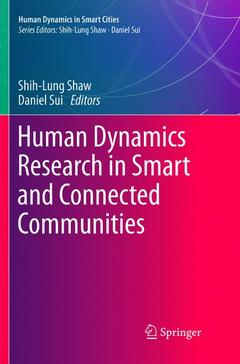Description
Human Dynamics Research in Smart and Connected Communities, 1st ed. 2018
Human Dynamics in Smart Cities Series
Coordinators: Shaw Shih-Lung, Sui Daniel
Language: English
Publication date: 06-2019
245 p. · 15.5x23.5 cm · Paperback
Publication date: 02-2018
Support: Print on demand
Description
/li>Contents
/li>Biography
/li>Comment
/li>
Shih-Lung Shaw is Alvin and Sally Beaman Professor and Arts and Sciences Excellence Professor of Geography at the University of Tennessee, Knoxville. He also serves as the interim associate provost for international education at the University of Tennessee, Knoxville. He received his B.S. degree from the National Taiwan University and his M.A. and Ph.D. degrees from the Ohio State University. His research interests cover geographic information science (GIScience), transportation geography, time geography, GIS for transportation (GIS-T), and space-time analytics of human dynamics. His recent research has focused on space-time analytics of human activities and interactions in a hybrid physical-virtual world based on various types of individual tracking data such as cell phone data, online social media data, vehicle tracking data, travel-activity survey data, and population migration data. His research has led to the development of a space-time GIS for representation, analysis, and visualization of individual activities and interactions in a hybrid physical-virtual space. Dr. Shaw is a Fellow of the American Association for Advancement of Science (AAAS). He also received the Edward L. Ullman Award for Outstanding Contributions to Transportation Geography from the Association of American Geographers (AAG) and served as the Head of the Department of Geography at the University of Tennessee, Knoxville.
Daniel Sui is an Arts and Sciences Distinguished Professor and Professor of Geography, Public Affairs, Public Health, and Urban/Regional Planning at the Ohio State University (OSU). He also serves as the Division Director for Social and Economic Sciences(SES) at the U.S. National Science Foundation. Prior his current appointment, professor Sui served as Chair of Geography (2011-2015) and as Director of the Center for Urban & Regional Analysis (CURA) (2009-2012) at OSU. Before joining the faculty of OSU in July 2009, Daniel Sui




